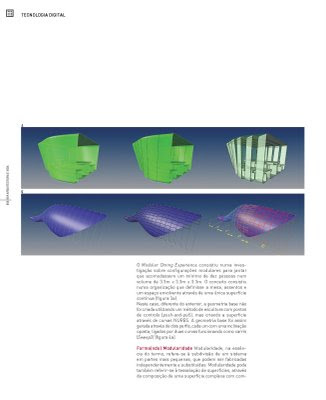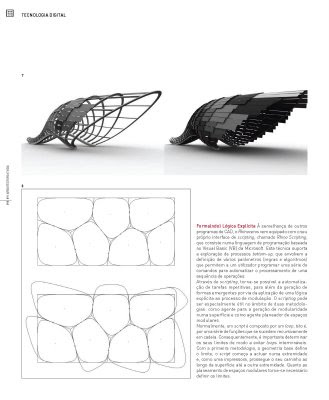i was invited to write an article by jose pedro sousa (www.re-d.com), coordinator of the digital technology section of the portuguese architecture magazine 'arquitectura e vida', for the april issue. entitled 'modularity - a rational approach to complexity' the article focuses on the use of digital technologies and processes in architecture, namely the process of simplifying complex geometries into smaller components facilitating fabrication, transportation, and assembly. here are the magazine spreads with the english text below. 





Modularity – A Rational Approach to Complexity
The primary focus of my research is modularity, not necessarily in the sense of mass produceable self-similar parts but more in the sense of breaking down complex geometries into identifiable, describable, elements for representation and fabrication. I'm interested in producing seamingly complicated forms with standard contruction methods and non-expensive materials. The research is process driven, it focuses on simplicity and maintaining clear formal gestures.
The digital platform with which I work is Rhinoceros developed by McNeel, traditionally used for industrial, automotive, and marine design it has become increasingly popular among architects. It is a free-form NURBS modeling software that provides a vast selection of tools for building, documenting, and fabricating complex geometries. Forming Complexity My design process normally begins with a top-down approach. First by generating a preconceived non-standard form that evolves from the design brief and then setting out in trying to deconstruct [rationalize] it into a series of elements [modules]. This form becomes the base geometry from which the modules will be referenced to and which all other building components will be extracted from. The underlying concept for the geometry of my proposal for the ‘DRL_Ten Pavilion’ competition was to create a biomorphic formal expression of the post-graduate program’s growth and evolution since its conception. The aim of the proposal was to test the structural capabilities of ‘fibre-c’, an advanced technology fibreglass reinforced concrete panel, as a suitable material for non-standard forms (Figura 1a & 1b). Similar to working with traditional plastic materials such as clay, the base geometry was sculpted from a planar NURBS surface. Using the ‘Rebuild’ tool to increase the amount of control points on the surface (Figura 2a), adding a greater degree of precision and control, the control points where then manipulated to generate the base geometry (Figura 2b). In order to specify the required depth of the structure I offset the finalized base geometry surface using the ‘OffsetSrf’ tool (Figura 2c). The ‘Modular Dining Experience’ was a mini-charrette investigating modular dining configurations suitable for at least ten people within a 3.3m x 3.3m x 3.3m volume. The concept was to have a sitting arrangement which included the table, seats, and spatial envelope created from one continuous surface (Figura 3a). Different then the previous example the base geometry was not created using a push-and-pull method of control points but rather by creating a surface from NURBS curves. The base geometry was formed using the ‘Sweep2’ tool between two profile sections [each having the envelope inclined in opposite directions] connected by two edge curves functioning as rails, providing greater control over the deformation of the surface (Figura 4a). Forming Modularity Modularity, in the pure sense of the word, refers to the subdivision of a system into smaller parts that can be independently manufactured and replaced. Modularity can also refer to surface tessellation by composing a complex surface with smaller components [modules], similar to mosaic tiles, which like in the automotive industry, can be replaced and interexchanged to create variations within the design. Extracting modules from the base geometry normally begins by applying onto the surface a grid that defines the maximum size a module can be. Depending on the complexity of the surface, and or the desire to have planar as apposed to curved modules, the grid may vary in its true spacing. This happens when applying an orthogonal cartesian grid onto a surface with variable curvature. In the case of the pavilion proposal, the concept was to pixilate the surface with flat fibre-c panels. In order to compensate for the variable surface curvature the central spine of the geometry was subdivided, using the ’Divide’ tool, into segments of a specified length to locate the placement of the grid lines on the surface (Figura 5a). Zones of similar curvature were created to define panel widths, allowing for panel repetition (Figura 5b). The base geometry was split by the grid lines into individual bays. Each bay was then flattened using the ‘CreateUVCrv’ tool to form guides for the placement of the panels in 2d (Figura 6a). Once the panels were laid out each strip was reapplied back onto the faceted bays in 3d using the ‘ApplyCrv’ tool. Because the base geometry contained double-curvature each module had to be flattened relative to its average normal by using the ‘SetPT’ tool (Figura 5c). Breaking apart the overall form of the pavilion into typical zones aided in reducing the number of moulds to five, each creating between four and six fibre-c module variations, resulting in a total of 22 unique panel types (Figura 6b). The panels were designed based on the structural principle of folding a flat sheet of material to increase its structural properties. The folded edges of the modules transfer vertical forces to the support structure below (Figura 6c). In the case of the ‘Modular Dining Experience’, the concept was to deconstruct the continuous double-curved surface into six striations of single-curvature. Using the ‘Contour’ tool a spaced series of planar curves were created over the base geometry (Figura 4b) and were then extruded in the same direction. Each extruded striation was then given a thickness by using the ‘OffsetSrf’ tool [with solid option selected] (Figura 4c). Each individual striation serves as a self-contained dining module for two that can be packed together to serve groups (Figura 3a) or pulled apart and completely separated for more intimate settings (Figura 3b). Both projects involve the creation of modularity by extracting information from a base geometry. While the pavilion attempts to facet the complex geometry by reconstructing it with flat panels the modular dining simply uses the base geometry as a starting position for the striations. Forming Explicit Logic Similar to other CAD software Rhino is equipped with its own scripting interface called Rhino scripting, a programming language based on Microsoft’s Visual Basic (VB). It is part of a bottom-up process that involves defining a set of parameters [rules and algorithms] which allow a user to program a series of commands to automate a sequence of operations.
Scripting provides the ability of automating repetitive functions as well as generating emergent forms by applying explicit logic to the modeling process. There are two methodologies in which scripting can be very useful within design: firstly as an agent for generating modularity of a surface and secondly as an agent for planning modular space. A script is normally composed from a loop, or series of looped functions. For this reason it is important to set limits so as to avoid having a script loop endlessly. With the first methodology the base geometry set’s the limit, the script will begin from one corner and work its way [like a printer] across the surface until it reaches the last corner. In planning modular space a boundary needs to be defined. In defining modularity of a surface one begins with a base geometry similarly to the previous examples. In the case of the ‘DRL_Ten Pavilion’, an alternate proposal experimented with creating a primary structure [using the same method of extracting structural elements from the base geometry] (figura 7a) and applying the fibre-c panels purely as cladding with no structural properties. A generative growth script was used to apply the overlapping flat panels onto the base geometry that varied in length and width depending on the surface curvature (figura 7b). ‘Cellular living’ was a study in creating a modular residence from a voronoi planar composition. A set of points were plotted to define general cell placements. The script plots a series of cells through the proximity of the points to each other and to the boundary [defined by the required floor plate area] (figura 8a). To avoid having a defined edge [caused by the boundary] the cells were individually edited to animate the exterior line as well as allow for terraces and balconies (figura 8b). The modular residences can be mass-produced [pre-manufactured and assembled on site] as detached single-family homes (Figura 9a & 9b), assembled together to form high-rise towers (Figura 9c) or horizontal residential blocks (Figura 9d).








